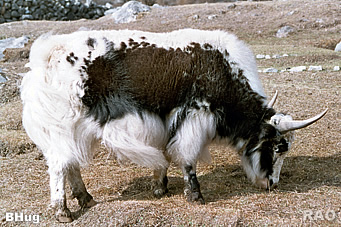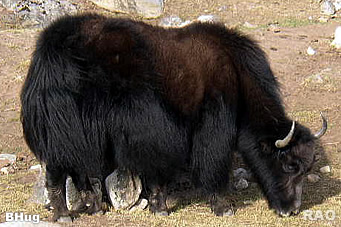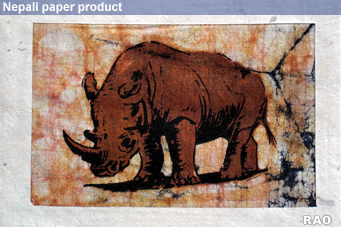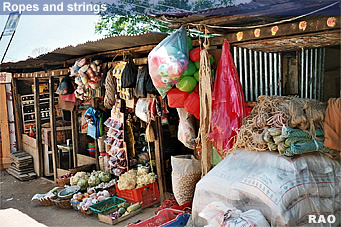 |
Charikot
and Dolakha - Trekkings |
| TRADITIONAL
CRAFTS & TECHNOLOGIES |
|
|
|
|
|
|
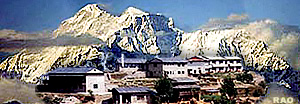 |
|
TRADITIONAL
CRAFTS & TECHNOLOGIES |
 |
|
Milk
Products |
 |
Milk
can be preserved for deferred consumption or for transport in a number
of ways. lf you trek through some Sherpa villages or meet their yak
and chauri herds along the trails you will certainly see, and if you
are willing to taste them, get to eat and drink their products.
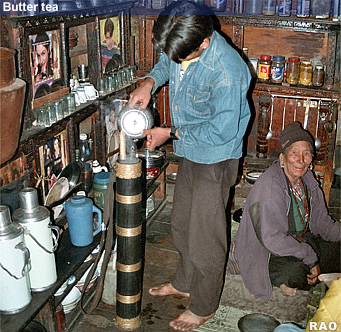 |
| Ghee
(butter) and mahi (thin curd)
Direct
separation of fat from milk is not possible in ihe traditional method.
Therefor, butter-making starts by letting the milk coagulate for 1 -3 days,
after filtering ard boiling it. lt is then poured into a big wooden container
known as a theki. There it is churned by a beater (madani) for 45 to 60 minutes.
This
chum-staff moves in alternate rotational movements caused by the pulling
of a leather strap which is wound around the axle of the beater.
Warm
water ts added during this process until the volume of the liquid is almost
doubled. |
|
In
this way the milk fat separates out and collects as a thick layer at the
mouth of the theki from where it is removed carefully. The residual
liquid is what is termed Mahi and is consumed fresh.
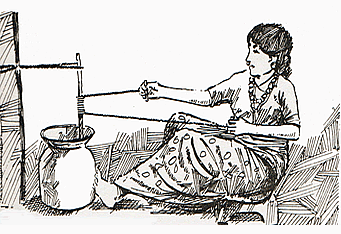 |
| Mahi-making |
| The
milk fat is until slowly heated over the fire the moisture vaporizes and
impurities are separated from the ghee or butter. The ghee is now
slowly decanted and poured into tins or drums for self-consumption or for
transport and sale (at high prices) in Kathmandu.
Further
refining may be necessary before it is sold on the market. However, there
is nothing better patatoes fried in Sherpa gee - do accept the offer
if you get one. |
|
top
|
Forest
Products |
 |
A
large number of people are still dwelling in our forests. For their own
use but also for sale they are producing many different goods:
Nepali
Paper (often incorrectly called rice paper)
Our
region is one of the main paper producing areas in the country. You will
find paper makers in and around Bharabise, in Suspa, Bigu and in
the Kalinchowk and Chardung forest ranges, from about December to
the beginning of monsoon.
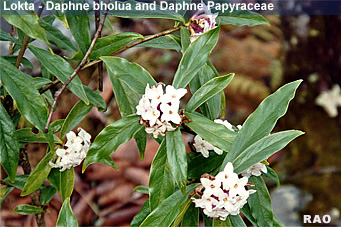 |
| The
raw material used is the inner bark of a shrub whose local name is lokta
(Daphne bholua and Daphne Papyraceae). A different plant is Daphne
edgeworthia here called Argheli from which people make ropes and strings. This lokta bark is dried and thoroughly soaked for
1 day. pulp is now placed in a wooden container and stirred with a mixer.
day. After being cleaned from impurities, it is boiled together with Khasru
(oak) ash for several hours. This is the most strenuous part of the
job; it takes 3 full hours tor just 2kg of pulp. |
|
The lokta
pulp is now placed in wooden containers and stirred with a mixer. The
resulting homogenous mass is poured into a bamboo-framed light cotton cloth
which is dipped in pond slowly running a water.This moulding process demands
considerable skill. The frame is put out in the sun and the thinly spread
out pulp will dry in another 2 hours.
The
income of traditional paper maker has a been calculated at about Rs.7 per
day, which is less than that of un-skilled manual labour or porter. Efforts
are being made to improve the quality paper from our area as well as the
marketing arrangements in order to increase the benefits directly accruing
to the producers. The big problem, however, is the decline in the raw material
availability. Only systematic Lokta management or the establishment of
plantations can solve this problem and save this old trade from extinction.
Allo
Allo
is the local name of the so-called stinging or Himalayan nettle (sisnurtica
dioica; family -urhcaceae). Traditional products from this nettle -
we hope that you will see some, but never touch one - include the head-strap
(namlo) used by the porters, bags, ropes, strings, fishing nets and
even cloths. lt grows willd in forests between 2000 and 3500 metres above
sea level.
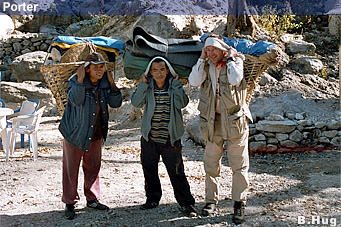 |
| The
thread from which the above products are woven on a back-strap loom is obtained in the following way:
The
stem is dried inner bark of the and then boiled, together with 3-4 hours
ash. Then it is cleaned with water and baten with a wooden hammer in order
to separate the binding material (lignin) from the fibre. The fibre
is now dipped into water mixed with maize or paddy husk. From this fibre
with a a very strong thread is obtained by hand-spinning small spindle
called katuwa. |
|
Due
to the competition from other raw materials (cotton, nylon, acryl wool)
the manufacture of Allo products is experiencing a slow decline.
Unfortunately, this affects mostly the low-caste women from the remote
hilly areas who are the main producers of such goods. At present, strong
efforts are being made to improve the processing technology for Allo and
to develop new products such as carpets which may find a market in Kathmandu
and overseas.
Charcoal
Charcoal
in our area has not so far been used for heating and cooking purposes,
but it is an essential pre-requisite for blacksmiths and goldsmiths because
of its calorific value. The traditional processing method consists of buming
partly dried wood in a circular pit covered with earth, fresh twigs and
leaves. This cover prevents too much air in-flow and a complete burning
of the wood into ashes.
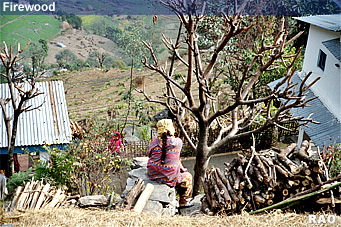 |
| The
Buming of the wood starts from the bottom where the charcoal is collected.
It takes several hours to produce a full load of charcoal. This industry
today is seriously threatening our forests, since the charcoal producers
are felling trees in an uncontrolled way instead of using, fallen or dead
trees from more remote areas. lf such trees could be used and the charcoal
be produced in portable kilns, a large number of jobs could be created
in those areas; at the same time this woulde alleviate the energy shortage
of the Kathmandu valley and its industries, since the transport of charcoal
is comparatively cheaper than that of firewood, when its calorific value
is taken into consideration |
|
|




